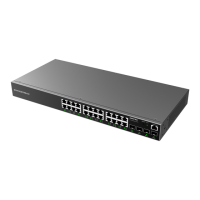
Do you have a question about the Grandstream Networks GWN780 Series and is the answer not in the manual?
| Operating Temperature | 0°C to 45°C (32°F to 113°F) |
|---|---|
| Managed | Yes |
| Power over Ethernet (PoE) | Available on select models (indicated by 'P' in the model name). PoE/PoE+ support. |
| Power Supply | Internal power supply. AC Input: 100-240V AC, 50-60 Hz |
| Layer | Layer 2+ |
| Mounting | Rack Mountable |
| Forwarding Rate | Varies by model |
| Jumbo Frame Support | Yes |
| Certifications | CE, FCC |
| Storage Temperature | -20°C to 60°C (-4°F to 140°F) |
General introduction to the GWN780x series switches and their capabilities.
Detailed technical parameters and features of the GWN780x series switches.
Lists all items included in the GWN780x switch package.
Details on how to install the switch on a desktop, wall, or in a standard rack.
Description and layout of the physical ports on GWN7801/P, GWN7802/P, and GWN7803/P models.
Procedure for properly grounding the GWN780x(P) switch for safety.
Steps to safely power on the switch and install an optional power cord anti-trip.
Instructions for connecting network cables to SFP and console ports.
Explanation of the different LED indicators on the switch front panel.
Overview of methods to access and configure the switch: Console, SSH, GWN.Cloud, Web UI.
How to use the search feature within the switch's web interface.
Details on accessing and interpreting the system information dashboard.
Configuration options for individual switch ports: speed, duplex, flow control, etc.
Configuring automatic port recovery mechanisms for network disruptions.
Setting up Link Aggregation (LAG) to combine multiple ports for increased bandwidth.
Managing dynamically learned and manually configured MAC addresses.
Configuring black hole addresses and managing port security MAC addresses.
Configuring VLAN membership, link types, and frame acceptance for ports.
Defining tagged and untagged VLAN members for individual ports.
Managing Organizationally Unique Identifiers (OUIs) for device identification.
Configuring STP to prevent network loops and ensure loop-free topology.
Enabling and configuring IGMP Snooping for efficient IPv4 multicast traffic management.
Global settings for IGMP Snooping: version, forward mode, and unknown packet handling.
Configuring IGMP snooping router ports for multicast traffic routing.
Adding static multicast addresses for IGMP snooping policies.
Creating policies to allow or reject multicast addresses for IGMP snooping.
Applying multicast policies to specific ports for IGMP snooping.
Global settings for MLD Snooping: version, forward mode, and unknown packet handling.
Configuring MLD snooping router ports for IPv6 multicast traffic routing.
Adding static multicast addresses for MLD snooping policies.
Creating policies to allow or reject IPv6 multicast addresses for MLD snooping.
Applying multicast policies to specific ports for MLD snooping.
Global PoE settings including total and remaining power, and supply voltage.
Configuring individual port PoE settings: power standard, mode, limit, and priority.
Setting port priority levels for traffic management and prioritization.
Mapping QoS priority values (CoS, DSCP, IP Precedence) to internal device priorities.
Configuring queue scheduling algorithms (Strict Priority, WRR) for traffic management.
Limiting packet rates and configuring interface-level traffic controls.
Configuring storm control to limit broadcast, multicast, and unicast traffic.
Securing network access by managing MAC addresses learned by ports.
Configuring port isolation to enforce Layer 2 data isolation between ports.
Creating and applying IPv4 and IPv6 ACLs for traffic filtering.
Creating MAC ACLs and binding ACLs to specific ports or LAGs.
Configuring RADIUS server for centralized network access authentication.
Configuring TACACS+ server for enhanced network access control.
Setting up Authentication, Authorization, and Accounting (AAA) for user access management.
Configuring DHCP Option 82 for relay agent information insertion.
General SNMP settings: engine IDs, server addresses, and enabling SNMP.
Creating MIB views and grouping SNMP users with access privileges.
Managing SNMP communities and configuring SNMPv3 user profiles.
Configuring SNMP notifications and trap receivers.
Overview of diagnostic tools: Logs, Ping, Traceroute, Mirroring, Fiber Module.
Viewing logs, configuring log servers, and testing network connectivity with ping.
Diagnosing network paths with traceroute and monitoring traffic with port mirroring.
Collecting and viewing network statistics and historical traffic data.
Configuring RMON events and alarms for proactive network monitoring.
Setting general parameters for LLDP and LLDP MED operation.
Defining network policies and configuring LLDP MED settings on a per-port basis.
Viewing LLDP information for local and neighboring network devices.
Viewing LLDP statistics for the local device and neighbors.
Performing manual firmware upgrades or via network using Grandstream firmware server.
Backing up and restoring switch configurations and performing factory resets.
Configuring the system time manually or via NTP server.
Managing login services: IP, idle timeout, Telnet, and SSH.
Creating and managing user accounts (Administrator, Operator, Monitor) with privileges.
Details of changes in firmware version 1.0.1.30.
Details of changes in firmware version 1.0.1.20 (initial version).